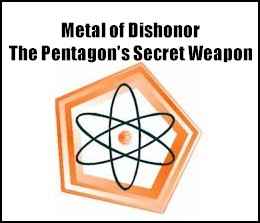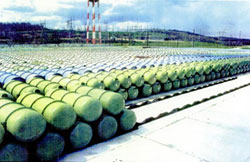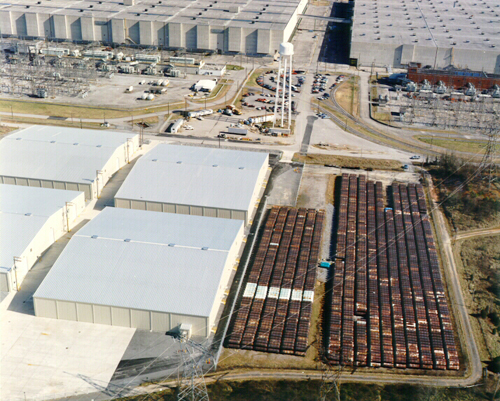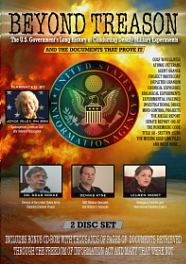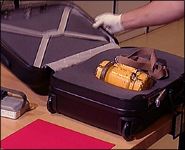|
Approximately
704,000 metric tons of depleted UF6 is stored in about 57,600 steel
cylinders that hold 9 - 12 metric tons of depleted UF6. The cylinders
are stored in large outdoor areas called "cylinder yards."
A program of regular surveillance and maintenance activities assures the safety of continued cylinder storage.
(This is not true. The numbers are much higher and the program of regular surveillance and maintenance activities assures their safety is nothing short of a joke.)
Transportation of Depleted Uranium Materials in Support of the Depleted Uranium Hexafluoride Conversion Program
Issues associated with transport of depleted UF6 cylinders and conversion products.
Conversion Plan Transportation Requirements
The DOE has prepared two Environmental Impact Statements (EISs) for the
proposal to build and operate depleted uranium hexafluoride (UF6)
conversion facilities at its Portsmouth and Paducah gaseous diffusion
plant sites, pursuant to the National Environmental Policy Act (NEPA).
The proposed action calls for transporting the cylinder at ETTP to
Portsmouth for conversion. The transportation of depleted UF6 cylinders
and of the depleted uranium conversion products following conversion
was addressed in the EISs.
Shipment of Radioactive Materials
Under the Department of Transportation Act of 1966, the U.S. Department
of Transportation (DOT) has regulatory responsibility for safety in
transportation of all hazardous materials, including radioactive
material. DOT developed a single a set of safety standards that assured
that properly prepared shipments of hazardous materials would be
acceptable for transport by all modes (rail, highway, air, and water).
These standards are set forth primarily in DOT's Hazardous Materials
Regulations (HMR) located in 49 CFR Parts 100 - 178.
Under the Atomic Energy Act of 1954, as amended, the U.S. Nuclear
Regulatory Commission (NRC) also has responsibility for safety in the
transport of radioactive materials. Due to the overlap in statutory
authorities of the NRC and DOT, the two agencies have a Memorandum of
Understanding (MOU) with regard to regulation of the transport of
radioactive material. Consistent with the MOU, the NRC has promulgated,
in 10 CFR Part 71, shipping requirements for radioactive materials.
The primary regulatory approach used by DOT and NRC for ensuring safety
during transportation of radioactive materials is by specifying
standards for the proper packaging of such materials. Packaging for
transporting radioactive materials must be designed, constructed, and
maintained to ensure that they will contain and shield their contents
during normal transportation. The type of packaging used is determined
by the radioactive hazard associated with the packaged material. The
hazard is determined by the characteristics of the specific radioactive
material and its physical form (e.g., solid, liquid, or gas). The
regulations also specify many requirements for labeling, marking,
training, and administrative controls.
The shipment of radioactive materials may take place by truck, rail, or
barge. Federal regulations do not place route restrictions on the
movement of depleted UF6 cylinders or depleted uranium on United States
highways or railroads.
It should be noted that the nuclear properties of depleted uranium are
such that the occurrence of a nuclear criticality (i.e., a nuclear
chain reaction) is not a concern, regardless of the amount of depleted
uranium present. However, criticality is a concern for the handling,
packaging, and shipping of enriched uranium. For enriched uranium,
criticality control is accomplished by employing, individually or
collectively, specific limits on uranium-235 enrichment, mass, volume,
geometry, moderation, and spacing for each type of package. The amount
of uranium that may be contained in an individual package and the total
number of packages that may be transported together are determined by
the nuclear properties of the enriched uranium.
Shipment of Depleted UF6 Cylinders
UF6 has been transported safely for more than 40 years. Specific
requirements exist for the shipment of UF6 cylinders. Among other
things, UF6 cylinders must be designed, fabricated, inspected, tested,
and marked in accordance with the version of American National Standard
N14.1, "Uranium Hexafluoride - Packaging for Transport" that was in
effect at the time the cylinder was manufactured. Although a detailed
discussion of depleted UF6 transportation regulations is not included
here, three requirements are particularly important relative to
depleted UF6 cylinder shipments: (1) cylinders must be filled to less
than 62% of the certified volumetric capacity (the fill-limit was
reduced to 62% from 64% around 1987); (2) the pressure within cylinders
must be less than 14.8 psia; and (3) cylinders must be free of cracks,
excessive distortion, bent or broken valves or plugs, and broken or
torn stiffening rings or skirts, and must not have shell thicknesses
that have decreased below a specified minimum value. Cylinders not
meeting these requirements are often referred to as substandard or
noncompliant.
Although the exact number is not yet known, preliminary reports suggest
that many of the cylinders at ETTP will not meet the DOT transportation
requirements. Three options exist for shipping these noncompliant
cylinders:
· The UF6 contents could be transferred from noncompliant cylinders into new or compliant cylinders.
· An exemption could be obtained from the DOT, allowing the UF6
cylinder to be transported either "as is" or following repairs. The
primary finding that DOT must make to justify granting an application
for an exemption is that the proposed alternative will achieve a level
of safety that either: (1) is at least equal to the level of safety
required by the otherwise applicable regulation; or, (2) if the
otherwise applicable regulations do not establish a required level of
safety, is consistent with the public interest and will adequately
protect against the risks to life and property inherent in the
transportation of hazardous materials in commerce.
· Noncompliant cylinders could be shipped in an "overpack." In this
case, the shipper would have to obtain an exemption from DOT allowing
the existing cylinder, regardless of its condition, to be transported
if it is placed into a metal overpack. The metal overpack would have to
be specially designed. Furthermore, DOT would have to determine that,
if the overpack is fabricated, inspected, and marked according to its
design, the resulting packaging (including the cylinder and the
overpack) would have a level of safety at least equal to the level of
safety required for a new UF6 cylinder.
Shipment of Depleted Uranium Conversion Products
The depleted uranium conversion product will be shipped as low specific
activity, group I, (LSA-I) material. All LSA materials have a
characteristic of presenting limited radiation hazard, because of their
relatively low concentration of radioactivity.
Evaluation of Transportation Risks
The EISs for the conversion project include a detailed evaluation of
the risks associated with the transportation of the depleted uranium
materials. This assessment includes the risks to both workers and
members of the public during normal transportation conditions and
hypothetical accidents.
Depleted UF6 Storage Safety
Continued cylinder storage is safe if the current surveillance and maintenance activities are continued.
(...and if not?...)
Potential Hazards of Cylinder Storage
The advanced age of some of the steel cylinders in which the depleted
UF6 is contained, and the way in which the cylinders were stored
(sometimes too close together to permit inspection, and sometimes in
direct contact with the ground, due to settlement of cylinders, leading
to enhanced cylinder corrosion) have created a potential environmental and safety hazard.
While depleted UF6 does not present as significant a radiological
hazard as other radioactive materials, it is a potential chemical
hazard if not properly managed.
(Nice of them to at least admit this much.)
Concerns Raised about Depleted UF6 Storage at Portsmouth
In October 1992, the Ohio Environmental Protection Agency (OEPA) issued
a Resource Conservation and Recovery Act (RCRA) Notice of Violation to
the Portsmouth Gaseous Diffusion Plant. The Notice of Violation stated
that the OEPA had determined depleted UF6 to be a solid waste, and that
the Department had violated Ohio laws and regulations by not evaluating
whether such waste was hazardous. The Department differed with this
assessment, and in February 1998, reached an agreement with OEPA, which
defers RCRA characterization of depleted UF6 stored at the Portsmouth
Plant until 2008, as long as the Department complies with a Depleted
UF6 Management Plan as agreed to by OEPA and makes good faith efforts
to evaluate potential use or reuse of the depleted UF6.
Concerns Raised about Depleted UF6 Storage at ETTP
The State of Tennessee raised nearly identical RCRA issues in 1997
regarding depleted UF6 stored at the East Tennessee Technology Park
(ETTP) near Oak Ridge. A negotiated settlement resulted in a consent
order issued by the Tennessee Department of Environment and
Conservation on February 8, 1999. Among other things, the order
requires conversion of all depleted UF6 stored at the ETTP, or removal
of the storage cylinders from the State by December 31, 2009.
(How do they plan to convert these materials and where are they going to move them too? - Yucca Mountain, Nevada?)
The PEIS and Cylinder Management Program
Following the OEPA Notice of Violation in 1992, the Department took the
initiative to re-evaluate its long-term strategy for managing the DUF6
inventory. In 1994, work began on the Program-matic Environmental
Impact Statement for Alternative Strategies for the Long-Term
Management and Use of Depleted Uranium Hexafluoride
<../../../guide/peis/index.cfm> (DOE/EIS-0269, April 1999).
In 1995, the Department also began an aggressive program to better
manage the aging depleted UF6 cylinders. In part, this program
responded to the Defense Nuclear Facilities Safety Board (DNFSB)
Recommendation 95?1, Safety of Cylinders Containing Depleted Uranium,
which DOE fully accepted. Included were more rigorous and frequent
inspections, painting and refurbishing of cylinders, and construction
of concrete-pad cylinder yards. The results of the analysis in the PEIS
indicated that continued cylinder storage is safe if
the current surveillance and maintenance activities are continued. The
Cylinder Management program's implementation has been successful, and
as a result, on December 16, 1999, the DNFSB closed out Recommendation
95-1.
Depleted UF6 Cylinder Leakage
A small number of cylinders have leaked over the last 40 years; leaking
cylinders are repaired, and material that leaks onto the ground is
removed.
(Where do they remove these materials too? What about the personnel that handles this material? Do they remove them too?)
Chemical Reactions During Leakage
If a cylinder leak (breach) occurs and the depleted UF6 is exposed to
water vapor in the air, uranyl fluoride (UO2F2) and hydrogen fluoride
(HF) are formed. The uranyl fluoride is a solid that plugs the leak,
limiting further escape of depleted UF6. Release of the hydrogen
fluoride gas to the atmosphere is also slowed by the plug formation.
(They know this because it has happened more than once...in this country...in your neighborhood.)
Historical Information about Leaks
Ten depleted UF6 cylinders have been breached (mainly from cylinder
wall cracks) over the past 40 years: most of the breaches were due to
corrosion around dents caused by mishandling, with the others due to
corrosion around welding defects or from external corrosion alone.
After the breaches were discovered, the material that leaked onto the
ground was removed, and the cylinders were repaired or the UF6 was
transferred to new cylinders. The cylinder yard workers and the
environment around the cylinder yards are constantly monitored for
potential radiation and chemical exposures and appropriate actions are
taken if higher-than-expected readings are obtained from monitoring
equipment.
(Again, they admit there is problems and will be more as this has been
going on for over 40 years. They want to transport this stuff
throughout our country, through your neighborhood on its way to some
place like Yucca Mountain.)
Leak Repair Procedures
When a valve leak is detected, the valve is replaced. When cylinder
wall corrosion or leakage is detected, the cylinder is repaired with a
patch, followed by a welded steel repair.
MAIN NOTE:
Where is the leaked material moved to and how is it handled and contained? (No mention of this.)
Cylinder Surveillance and Maintenance
DOE has a Cylinder Management program in place to inspect and maintain
depleted UF6 cylinders, and to improve their storage conditions.
Background
Since 1990, DOE has conducted a program of cylinder inspections,
recoatings, and relocations to assure that depleted UF6 is safely
stored pending its ultimate disposition. The program has so far been
largely focused on the ongoing surveillance and maintenance of the
cylinders containing depleted UF6.
In 1995, the Department began an aggressive program to better manage
the aging depleted UF6 cylinders. In part, this program responded to
the Defense Nuclear Facilities Safety Board (DNFSB) Recommendation
95-1, Safety of Cylinders Containing Depleted Uranium, which DOE fully
accepted. Included were more rigorous and frequent inspections,
painting and refurbishing of cylinders, and construction of
concrete-pad cylinder yards. The results of the analysis in the PEIS
indicated that continued cylinder storage is safe if the current
surveillance and maintenance activities are continued. The Cylinder
Management program's implementation has been successful, and as a
result, on December 16, 1999, the DNFSB closed out Recommendation 95-1.
Surveillance and Maintenance Program Duration
It will take decades to convert the depleted UF6 in the inventory to a
more stable chemical form. As a result, the Department intends to
continue surveillance and maintenance of the depleted UF6 cylinders
currently in storage.
Surveillance and Maintenance Program Activities
The day to day management of the depleted UF6 cylinders includes
actions designed to cost effectively improve their storage conditions,
such as:
· Performing regular inspections and general maintenance of cylinders and storage yards;
· Restacking and respacing the cylinders to improve drainage and to allow for more thorough inspections;
· Repainting ends of skirted cylinders and repainting cylinder bodies as needed to arrest corrosion; and
· Constructing new concrete cylinder storage yards and
reconditioning existing yards from gravel to concrete to improve
storage conditions.
The above information is compiled from: Argonne National Laboratory - January 2006
About Argonne
Argonne National Laboratory administers this web site for The U.S. DOE Office of Environmental Management.
Responsibilities
The Depleted UF6 Management Program Information Network web site is
administered by the Environmental Assessment Division of Argonne
National Laboratory for the United States Department of Energy (DOE) , Office of Environmental Management (EM) .
EM is responsible for preparation of the Depleted UF6 Conversion
Facility EISs. Argonne is assisting EM in preparation of the EISs.
About the Office of Environmental Management (EM)
In 1989, the Department of Energy created the Office of Environmental
Management (EM) to mitigate the risks and hazards posed by the legacy
of nuclear weapons production and research. Although the nation
continues to maintain an arsenal of nuclear weapons, as well as some
production capability, the United States has embarked on new missions.
The most ambitious and far ranging of these missions is dealing with
the environmental legacy of the Cold War. Like most industrial and
manufacturing operations, the nuclear complex has generated waste,
pollution, and contamination. However, many problems posed by its
operations are unique. They include unprecedented amounts of
contaminated waste, water, and soil, and a vast number of contaminated
structures that will remain radioactive for thousands of years.
About Argonne National Laboratory
Argonne National Laboratory is one of the U.S. Department
of Energy's largest research centers. It is also the nation's first
national laboratory, chartered in 1946. Today, the laboratory has more
than 4,000 employees, including about 1,400 scientists and engineers,
of whom about 700 hold doctorate degrees.
The Environmental Assessment Division
of Argonne National Laboratory conducts applied research, assessment,
and technology development in the following areas: risk and waste
management; natural resource systems and integrated assessments;
restoration, compliance, and pollution prevention; and environmental
policy analysis and planning. Most of these efforts support federal
agencies that have responsibilities for energy development and use,
natural resource management, or national defense.
For More Information:
Contact the Depleted UF6 Webmaster:
Robert Sullivan
Environmental Assessment Division
Argonne National Laboratory
Argonne, IL 60439
(630)252-6182
duf6webmaster@anl.gov

In January 2001, news media in many parts of the world carried reports
that postulated links between NATO's use of Depleted Uranium ammunition
in Kosovo and Bosnia with allegedly higher incidences of leukemia,
other cancers, and other negative health effects said to be occuring
among NATO troops who had served in those areas and among local
civilian populations.
Although a very large body of existing scientific and medical research
clearly established that such a link between Depleted Uranium
ammunition and the reported illnesses was extremely unlikely, NATO
Secretary General George Robertson immediately established an Ad Hoc
Committee on Depleted Uranium to serve as a clearing house for
information to be shared among interested nations.
To date, the scientific and medical research continues to disprove any
link between Depleted Uranium and the reported negative health effects.
Furthermore, the present evidence strongly suggests that NATO troops
serving in the Balkans are not suffering negative health effects
different from those suffered by their colleagues who have not served
in the Balkans. Nevertheless, NATO is not complacent about this matter,
and will continue to share information about this issue.
Review
Depleted uranium: an overview of its properties and
health effects S. Shawky1 1Department of Community Medicine and Primary
Health Care, College of Medicine and Allied Health Sciences, King
Abdulaziz University, Jeddah, Saudi Arabia.
Volume 8, No. 2&3 , March 2002.
SUMMARY
There has been much debate about the use of depleted uranium in the
Gulf War and its health effects on United States and European war
veterans. However, studies on the impact of this radioactive substance
on the residents of the surrounding Gulf region are far from adequate.
Depleted uranium intro-duces large quantities of radioactive material
that is hazardous to biological organisms, continues to decay for
millennia and is able to travel tens of kilometres in air. If depleted
uranium were used in the Gulf War, its impact on the health of people
in the area would have been considerable. This review of depleted
uranium — its origin, properties, uses and effects on the human
environment and health — aims to trigger further research on this
subject.
Introduction
Many debates about the use of depleted uranium in the Gulf War have
been held in industrialized countries. Some claim that depleted uranium
was used extensively in place of tungsten for ordnance by the United
States (US) and United Kingdom (UK) forces [1,2]. It has been suggested
that at least 320 tons of depleted uranium were used during the war and
much of that was converted at high temperatures into an aerosol of
minute insoluble particles of uranium oxide [1]. The fact that depleted
uranium was detected in the urine of Gulf War veterans seven to eight
years after the war is substantial evidence of long-term internal
contamination and tissue storage of this substance [1,3,4].
For some years after the Gulf War, many US and European veterans
deployed in the region during the war complained of vague
incapacitating symptoms that have been termed ‘Gulf War syndrome’
[5,6]. The US Department of Defense treated this illness as
‘post-traumatic stress disorder’ and advised military doctors to treat
it with muscle relaxants and sleeping pills while ordering a mental
illness assessment [1]. Arguments about the issue have continued for
years, some authors describing it as a myth invented by the media [7],
others documenting the symptoms reported by the veterans. These
symptoms were multiple, consisting mainly of chronic fatigue, headache,
muscle and joint pain, sleep disturbances, bladder dysfunction,
sweating disturbances, skin manifestations, menstrual disorders, as
well as neurological, psychological, respiratory, gastrointestinal and
cardiac symptoms [5,6,8]. Over time, the focus shifted to more serious
health risks and a number of dangerous conditions became linked to
depleted uranium exposure. These included cancers of different types,
renal diseases, as well as congenital anomalies and perinatal deaths
among the neonates of veterans [3,9–14]. These health concerns
triggered an explosion of interest in the subject as the affected
veterans started to campaign for more information about the
relationship between their illnesses and exposure to depleted uranium.
If the Gulf War veterans who were temporarily stationed in the region
were indeed victims of depleted uranium, what could have been the
impact of this substance on the health of the residents of the region
and surrounding countries?
Most studies from Iraq have concentrated on the impact of the United
Nations’ sanctions against Iraq on nutritional deficiencies and on
children’s health. A few studies in the Gulf countries have noted an
increased incidence of abortion and perinatal and infant mortality
since the Gulf War [15–17], but no adequate in-depth research has been
performed on the link between the war and serious health conditions.
Many issues concerning the effect of depleted uranium on the health of
the residents of the war countries and the surrounding regions remain
unexplored.
This review of depleted uranium—its origin, properties, uses and impact
on the human environment and health—aims to trigger further research on
the subject. Internet and MEDLINE searches were performed to extract
information on depleted uranium and its health effects. Information was
mainly taken from published research on depleted uranium in general and
from the Gulf War in particular.
Origin of depleted uranium [1,18,19]
Natural uranium is the heaviest naturally occurring element on earth.
It is widely distributed in the earth’s crust but is concentrated in
certain rock formations. Natural uranium has both radioactive and
fissive properties and is known to be the deadliest metal on earth.
Radioactivity is caused by unstable atoms exploding microscopically to
form a series of new substances called ‘decay products’, emitting
energy in the form of alpha and beta particles and gamma rays. The
fission process requires highly sophisticated technology to bombard
uranium atoms with neutrons, splitting them into two or three pieces
and releasing a high degree of energy and more neutrons with great
force. This splits more atoms and starts a chain reaction, producing
substances called ‘fission products’. Radioactivity and fissionability
are two completely different processes and release different products.
Radioactivity is not triggered and so cannot be controlled, whereas
fission can be started, stopped, slowed or speeded. It is fission that
allows uranium to be used in nuclear electricity generation and in
nuclear weapons. Natural uranium occurs in soil at about 1 to 3 parts
per million whereas in uranium ore it is about 1000 times more
concentrated, reaching about 0.05% to 0.20% of the total weight.
Natural uranium is a blend of uranium-235 (U-235) and uranium-238
(U-238). The U-235 is the fissionable part and can be used directly but
it is rare and constitutes only 1% of natural uranium. Thus at a
uranium enrichment plant, the concentration of U-235 is increased by
discarding some U-238. This cast-off uranium, which is almost 100%
uranium (mainly U-238), is called depleted uranium.
Radioactive decay products of depleted uranium [1,18,20]
Depleted uranium is thus a nuclear waste by-product of uranium
enrichment and has the same properties as metallic natural uranium. As
the concentration of uranium in depleted uranium is much higher than in
its natural state, depleted uranium is more radioactive than natural
uranium. Figure 1 shows the radioactive decay products of depleted
uranium, their half-lives and the type of energy emitted (alpha or beta
particles or gamma rays). It can be seen that radium is one of the
decay products of U-238. Radium disintegrates into radon gas that in
turn decays into the extremely dangerous ‘radon daughters’ or ‘radon
progeny’, of which there are about half a dozen radioactive materials
including polonium, the most toxic of all radon daughters. Finally,
this progression ends with lead, which is a stable highly toxic
substance. Figure 2 shows the radioactive decay products of the radon
progeny. The very long half-life of U-238 means that depleted uranium
remains radioactive for billions of years and over these periods will
continue to produce radioactive decay products. Thus, depleted uranium
becomes more radioactive over the centuries and millennia because the
decay products accumulate.
Figure 1 = Radioactive decay products of depleted uranium, their half lives (shown in brackets) and type of energy emitted:
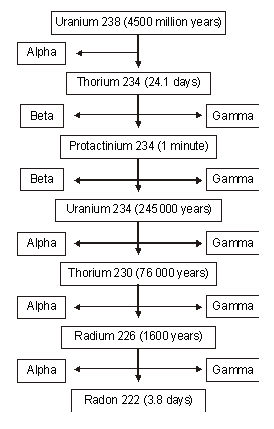
Figure 2 = Radioactive decay products of the radon progeny, their half
lives (shown in brackets) and type of energy emitted: alpha or beta
particles or gamma rays:

Uses of depleted uranium [1,19,20]
Depleted uranium has several military and peacetime uses. In military
settings it can be used to breed plutonium, a powerful nuclear
explosive; to double the explosive power of a hydrogen bomb; to coat
conventional bullets and shells to improve their armour-piercing
capabilities; and to provide armour-plating to tanks and other
vehicles. The peacetime uses include: counterweights in aeroplanes;
shields against radiation in medical radiotherapy units; and transport
of radioactive isotopes.
Environmental pollution with depleted uranium [1,20,21]
Depleted uranium ignites at high temperatures, producing uranium oxide
particles (UO2 and UO3) that are insoluble in water. The particles
resist gravity and are able to travel tens of kilometres in air. Once
on the ground, they can be resuspended and continue travelling when the
soil or sand is disturbed by motion or wind. They contaminate the soil,
ground water and river systems. Radioactive materials can also be
carried long distances in the bodies of animals, fish, birds and
insects. Thus, depleted uranium seeps into water, food and air and
introduces into the human environment very large quantities of
long-lasting radioactive materials, all of which are hazardous to
biological organisms.
Human exposure to depleted uranium [18–20]
Human exposure to depleted uranium can be external or internal.
External exposure occurs through proximity to depleted uranium metal or
through contact with dust or shrapnel following an explosion or impact.
Internal exposure occurs by ingestion of food and water contaminated
with depleted uranium, as well as inhalation of depleted uranium that
has been deposited in the environment or resuspended in the atmosphere
by wind or other disturbances. In the military environment, humans can
be exposed to radiation through wounds, if these are caused by the
impact of depleted uranium projectiles or armour.
Health hazards of depleted uranium [1,17–20]
Depleted uranium and its decay products are extremely dangerous and
remain radioactive even inside the human body. During the radioactive
decay, tiny electrically charged alpha and beta particles and gamma
rays are emitted that travel very fast. Some radioactive materials are
alpha emitters and others are beta emitters. An alpha particle is made
up of two protons and two neutrons whereas a beta particle is made up
of a single electron. The gamma rays are not material particles but a
form of pure energy travelling at the speed of light. Gamma rays
penetrate very fast through the soft tissues. Beta particles have less
penetrating power, travelling less than two centimetres in soft tissue.
Alpha particles are the weakest, travelling just a few microns in soft
tissue (equivalent to a few cell diameters). Thus, outside the body,
alpha emitters are the least harmful because alpha particles are hardly
able to penetrate the outer layer of the epidermis. Beta particles are
able to penetrate the outer layers of the skin and reach the basal
layer, giving a localized dose to the skin when contact is high. Gamma
emitters are the most dangerous as gamma radiation can penetrate into
internal organs, depending on the energy of the gamma radiation.
However, although alpha particles cannot penetrate the epidermis, they
are extremely hazardous when taken into the body. Alpha particles that
are emitted within the body deposit energy more densely than either
beta particles or gamma radiation and are consequently more
destructive.
Cycle of depleted uranium inside the human body [10,18,21]
Internal contamination with depleted uranium occurs through inhalation
or ingestion of depleted uranium particles. Once inhaled, very small
insoluble particles of uranium oxide (2.5 mm or less in diameter) can
reside in the lungs for years, slowly passing through the lung tissue
into the blood. As a result of coughing and other involuntary
mechanisms by which the body keeps large particles out of the lungs,
the larger particles pass through the gastrointestinal tract. Around
0.2% of insoluble depleted uranium and 2.0% of the soluble depleted
uranium taken in food and water are absorbed by the gut. Over 95% of
the depleted uranium entering the body is not absorbed but is
eliminated via the faeces. Of the depleted uranium that is absorbed
into the blood, approximately 67% will be filtered by the kidneys and
be excreted in the urine within 24 hours, increasing to 90% within a
few days. The unexcreted depleted uranium is distributed around the
body and stored in bones, kidneys, liver and other tissues.
Health effects of depleted uranium [17–26]
The human body has no way of protecting itself from depleted uranium in
water, food or air. External exposure to depleted uranium leads to
radiological toxicity, while the effects of internal contamination with
depleted uranium are complex, caused by both chemical and radiological
mechanisms. The detailed mechanism of radiation toxicity is a subject
of continuing research. However, it is thought that one of the ways in
which the deposited energy may damage cells is by causing changes in
deoxyribonucleic acid (DNA), a biologically important molecule that
controls all aspects of structure and function and which is mainly
found in cell nuclei. Two types of health effects have been
demonstrated: deterministic and stochastic. The deterministic effects
depend on the dose of radiation. Massive exposure can lead to death
within a few days or weeks. Lower doses cause burns, erythema, loss of
hair or other effects on the skin. The primary stochastic effect
associated with radiation exposure is cancer. Radiation causes direct
damage to cell DNA. The damaged cells that die, as long as they are not
too many, are not a real problem, but the damaged cells that survive
may reproduce in an abnormal and uncontrolled fashion, becoming cancer
cells. As the cancer spreads, it destroys the healthy tissue and unless
treated it eventually kills the host. Cancers of all kinds can result
from internal radiation exposure, depending on the organ affected. In
the case of inhalation of insoluble depleted uranium particles, the
upper aerodigestive tract and the lungs are the first target organs, in
which case tissue damage and an increased probability of cancers is
these areas would be expected. The bone is one of the main places where
depleted uranium is stored, leading to uncontrolled production of white
blood cells to the detriment of other cells, ultimately leading to
leukaemia. It takes many years for a cancer caused by contaminated air,
food or water to grow, so the effect is not apparent immediately.
Exposure to radiation can also affect the reproductive system, causing
infertility or damage to the father’s sperm or mother’s egg. Genetic
damage is possible, leading to spontaneous abortion, premature death or
congenital anomalies. Some forms of genetic damage are not seen in the
first or second generations but only later after several generations
have passed. Another danger of exposure to low-dose radiation is
biological damage in the form of monocyte depletion, leading to iron
deficiency anaemia and a depressed cellular immune system. Radiation
also deforms red blood cells, inhibiting their passage into the tiny
capillaries and depriving the muscles and brain of adequate oxygen and
nutrients. This can lead to impairment of many organs especially the
kidneys, liver, lungs and cardiovascular and haematopoietic systems.
Radiation can cause disorders of protein and carbohydrate metabolism,
leading to symptoms ranging from severe headache to brain dysfunction.
Mental retardation owing to brain damage of the fetus has also been
described as a result of radiation exposure in the womb during the
critical period when the child’s brain is being formed. The chemical
toxicity of depleted uranium results from its interaction with the
biochemical processes of the human body. Chemically, depleted uranium
damages kidney function in humans. The proximal tubules are the main
site of potential damage. The types of damage that have been observed
are nodular changes to the surface of the kidney, lesions to the
tubular epithelium and increased levels of glucose and protein in the
urine.
Conclusion
If depleted uranium were indeed used in the Gulf War, it will certainly
have constituted an enormous health hazard not only to the US and
European veterans deployed in the region during the war but also to the
residents of the war countries and surrounding areas. The extent of the
region affected has not been determined and the long-term dangers
remain unidentified.
(Update – January 2006: Regions of affected areas since 1988 are –
Bosnia, Kosovo, Yugoslavia, Iraq, Iran, Afghanistan, parts of Syria and
those areas where DU is stored before and after use.)
Many issues concerning this subject need to be resolved through
extensive public health action and intense epidemiological research.
References
1. Bertell R. Gulf War veterans and depleted uranium. Paper prepared for the Hague Peace Conference 11–15 May 1999.
2. Mathews J. Radioactive bullets raise cancer fears. Journal of the National Cancer Institute, 1993, 85(13):1029–30.
3. McDiarmid MA et al. Health effects of depleted uranium on exposed
Gulf War veterans. Environmental research, 2000, 82(2):168–80.
4. Hooper FJ et al. Elevated urine uranium excretion by soldiers with
retained uranium shrapnel. Health physics, 1999, 77(5):512–9.
5. Beers MH, Berkow R, Burs M, eds. The Merck manual, 17th ed. Rathway, New Jersey, Merck & Co, 1999:2480.
6. Jamal GA. Gulf War syndrome: a model for the complexity of
biological and environmental interaction with human health. Adverse
drug reactions and toxicological reviews, 1998, 17(1):1–17.
7. Nicolson GL, Nicolson NL. The eight myths of Operation ‘Desert
Storm’ and Gulf War syndrome. Medicine, conflict, and survival, 1997,
13(2):140–6.
8. Steele L. Prevalence and patterns of Gulf War illness in Kansas
veterans: association of symptoms with characteristics of person,
place, and time of military service. American journal of epidemiology,
2000, 152(10):992–1002.
9. Knoke JD, Gray GC, Garland FC. Testicular cancer and Persian Gulf War service. Epidemiology, 1998, 9(6):648–53.
10. Durakovic A. Medical effects of internal contamination with uranium. Croatian medical journal, 1999, 40(1):49–66.
11. Doyle P, Roman E, Maconochie N. Birth defects among children of
Gulf War Veterans. New England journal of medicine, 1997,
337(16):1175–6.
12. Araneta MR et al. Goldenhar syndrome among infants born in military
hospitals to Gulf War veterans. Teratology, 1997, 56(4):244–51.
13. Haley RW et al. Brain abnormalities in Gulf War syndrome:
evaluation with 1H MR spectroscopy. Radiology, 2000, 215(3):807–17.
14. Cannova JV. Multiple giant cell tumors with Gulf War syndrome. Military medicine, 1998, 163(3):184–5.
15. Rajab KE, Mohammad AM, Mustafa F. Incidence of spontaneous abortion
in Bahrain before and after the Gulf War of 1991. International journal
of gynae-cology and obstetrics, 2000, 68(2):139–44.
16. Ascherio A et al. Effect of the Gulf War on infant and child
mortality in Iraq. New England journal of medicine, 1992, 327
(13):931–6.
17. Makhseed M et al. Post-war changes in the outcome of pregnancy in
Maternity Hospital, Kuwait. Medicine, conflict, and survival, 1996,
12(2):154–67.
18. Edwards G. Uranium: known facts and hidden dangers. World uranium hearings. Salzburg, Austria, September 14, 1992.
19. Depleted uranium. Geneva, World Health Organization, 2001 (Fact sheet no. 257).
20. Depleted uranium: sources, exposure and health effects. Geneva, World Health Organization, 2001.
21. Fresquez PR et al. The uptake of radionuclides by beans, squash,
and corn growing in contaminated alluvial soils at Los Alamos
Laboratory. Journal of environmental science and health. Part B, 1998,
33(1):99–121.
22. Wedeen RP. Renal diseases of occupational origin. Occupational medicine, 1992, 7(3):449–63.
23. Bertell R. Internal bone seeking radionuclides and monocyte counts.
International perspectives in public health, 1993, 9:21–6.
24. Bertell R, ed. Handbook for estimating health effects from exposure
to ionizing radiation, 2nd ed. Buffalo, New York, Institute of Concern
for Public Health, 1986.
25. Sources, effects and risks of ionizing radiation. New York, United
Nations Scientific Committee on the Effects of Atomic Radiation, 1998.
26. Ritz B et al. The effects of internal radiation exposure on cancer
mortality in nuclear workers at Rocketdyne/Atomics International.
Environmental health perspectives, 2000, 108(8):743–51.
A Process for Reducing the Licensing Burden for
New Products Containing Depleted Uranium
Citation
ANL/EAD/TM/03-01
Authors
Ranek, Nancy L.; Kamboj, Sunita; Hartmann, Heidi M.; Avci, Halil I.
Document Type
TM
Publication Year
2003
(New Products containing Depleted Uranium? Like what - bumpers on our
cars; window and door frames in our houses; lunch-boxes for our kids?)
Avoiding Destructive Remediation at DOE Sites
Whicker, F.W.; MacDonell, Margaret M.; Hinton, T.G.; Pinder, III, J.E.; Habegger, Loren J.
Development of an Analytical Methodology for Sarin (GB) and Soman (GD) in Various Military-Related Wastes
O'Neill, Hugh J.; Brubaker, Kenneth L.; Schneider, John F.; Sytsma, Louis F.; Kimmell, Todd A.
Discrete Charm of Cooperative Federalism: Environmental Citizen Suits in the Balance, The
Puder, Markus
Environmental Policy and Regulatory Constraints to Natural Gas Production
Elcock, Deborah
Final Environmental Impact Statement for Construction of a Depleted
Uranium Hexafluoride Conversion Facility at the Portsmouth, Ohio, Site
Life-Cycle Evaluation of Alternative Configurations for Shipping Low-Level Radioactive Waste to the Nevada Test Site
Daling, P.M.; Biwer, Bruce M.; Siebach, Peter R.; Ross, Steven B.
Measurement Uncertainties and Minimum Detectable Concentrations for the In Situ Nal Gamma Spectroscopy Systems Used at Fernald
Davis, Michael J. (EA)
Modeling the Suitability of Potential Wetland Mitigation Sites with a Geographic Information System
Van Lonkhuyzen, Robert A.; LaGory, Kirk E.; Kuiper, James A.
Process for Reducing the Licensing Burden for New Products Containing Depleted Uranium, A
Ranek, Nancy L.; Kamboj, Sunita; Hartmann, Heidi M.; Avci, Halil I.
Voluntary Cleanup of the Ames Chemical Disposal Site
Taboas, Anibal L.; Freeman, Richard; Peterson, John M.
Environmental Research Division Publications, 1999-2005
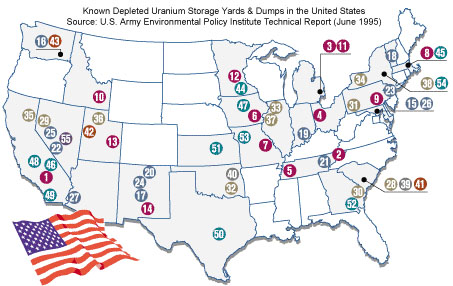
Discounted Casualties
The Human Cost of Depleted Uranium
|
Fabrication, Assembly, R & D, Test Firing, Storage and
Demilitarization Sites involving DU Ammunition in USA
[Source: US Army Environmental Policy Institute
Technical Report (June 1995) ]
|
| Fabrication and Assembly Sites |
| 1 |
Aerojet Ordnance Company |
Chino, California |
| 2 |
Aerojet Ordnance Tennessee |
Jonesboro, Tennessee |
| 3 |
Detroit Army Tank Plant |
Warren, Michigan |
| 4 |
Lima Army Tank Plant |
Lima, Ohio |
| 5 |
Martin Marrietta Energy Systems
Milan Army Ammunition Plant |
Milan, Tennessee |
| 6 |
Mason and Hanger at Iowa Army Ammunition
Plant |
Middletown, Iowa |
| 7 |
National Manufacturing Corporation |
St. Louis, Missouri |
| 8 |
Starmet Corporation, formerly known as Nuclear
Metals, Inc. |
Concord, Massachusetts |
| 9 |
Olin Ordnance Corporation |
Red Lion, Pennsylvania |
| 10 |
Specific Manufacturing Capability Facility
Idaho National Engineering Laboratory |
Idaho Falls, Idaho |
| 11 |
Tank Automotive Command |
Warren, Michigan |
| 12 |
Twin Cities Army Ammunition Plant,
Alliant Tech Systems |
New Brighton, Minnesota |
| 13 |
White Sands Missile Range |
Green River, Utah |
| 14 |
White Sands Missile Range |
White Sands, New Mexico |
| R & D and Test Firing Sites |
| 15 |
Army Research Laboratory |
APG, Maryland |
| 16 |
Battelle Pacific Northwest Labs |
Richland, Washington |
| 17 |
Energetic Materials Research and Technology
Center, formerly known as the Terminal Effects
Research and Analysis(TERA) facility |
Socorro, New Mexico
|
| 18 |
Ethan Allen Firing Range (General Electric) |
Burlington, Vermont |
| 19 |
Jefferson Proving Ground |
Madison, Indiana |
| 20 |
Los Alamos National Laboratory |
Los Alamos, New Mexico |
| 21 |
Manufacturing Sciences Corp. |
Oak Ridge, Tennessee |
| 22 |
Nevada Test Site |
Mercury, Nevada |
| 23 |
Picatinny Arsenal |
Dover, New Jersey |
| 24 |
Sandia National Laboratories |
Albuquerque, New Mexico |
| 25 |
Tonopah Test Range |
Tonopah, Nevada |
| 26 |
US Army Combat Systems Test Activity |
APG, Maryland
|
| 27 |
Yuma Proving Ground |
Yuma, Arizona |
| Storage and Storage/Demilitarization Sites |
| 28 |
Defense Consolidation Facility |
Snelling, South Carolina |
| 29 |
Hawthorne Army Ammunition Plant |
Hawthorne, Nevada |
| 30 |
Hunter Army Airfield |
Savanna, Georgia |
| 31 |
Letterkenny Army Depot |
Chambersberg, Pennsylvania |
| 32 |
McAlester Army Ammunition Plant |
McAlester, Oklahoma |
| 33 |
Savanna Army Depot |
Savanna, Illinois |
| 34 |
Seneca Army Depot Activity |
Romulus, New York |
| 35 |
Sierra Army Depot |
Herlong, California |
| 36 |
Tooele Army Depot |
Tooele, Utah |
| 37 |
US Army Armament Munitions and Chemical Command |
Rock Island, Illinois |
| 38 |
Watervliet Arsenal |
Albany, New York |
| Processing Sites |
| 39 |
Carolina Metals |
Barnwell, South Carolina |
| 40 |
Sequoyah Fuels Corporation |
Gore, Oklahoma |
| Waste Disposal Sites |
| 41 |
Chem-Nuclear Systems Waste Management Facility |
Barnwell, South Carolina |
| 42 |
Envirocare of Utah, Inc. |
Clive, Utah |
| 43 |
US Ecology |
Hanford, Washington |
| Former DU Use or Storage Sites, and Sites
Being Decommissioned |
| 44 |
Alliant Tech Systems, Inc. |
Elk river, Minnesota |
| 45 |
Army Research Laboratory |
Watertown, Massachusetts |
| 46 |
Camp Roberts Military Reservation |
Bradley, California |
| 47 |
Chamberlain Manufacturing |
Waterloo, Iowa |
| 48 |
China Lake Naval Weapons Center Alliant Tech
Systems |
Ridgecrest, California |
| 49 |
Ford Aerospace and Communications Corp. |
San Juan Capistrano, California |
| 50 |
Fort Hood |
Killeen, Texas |
| 51 |
Fort Riley |
Junction City, Kansas |
| 52 |
Fort Stewart |
Hinesville, Georgia |
| 53 |
Lake City Army Ammunition Plant |
Independence, Missouri |
| 54 |
National Lead Industries |
Colonie, New York |
| Other |
| 55 |
Nellis Air Force Firing Range
*Not mentioned in the Army Technical Report,
but still in use |
Nevada |
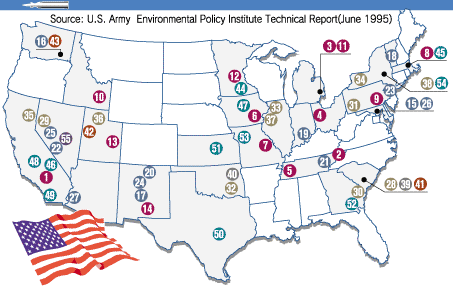
|


